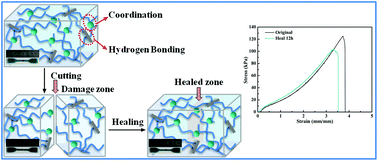A facile strategy to fabricate highly-stretchable self-healing poly(vinyl alcohol) hybrid hydrogels based on metal–ligand interactions and hydrogen bonding†
Abstract
Self-healing polymeric hydrogels have attracted tremendous attention owing to their great potential in a wide range of applications. However, it is still a big challenge to develop shape-memory hydrogels with both superior mechanical performance and excellent self-healing capacity. In this work, we report a facile strategy to fabricate highly-stretchable poly(vinyl alcohol) (PVA) hybrid hydrogels with excellent self-healing capacity, simply by introducing copper(II) ions (Cu(II)) and fibrous sepiolite (Sep) into PVA solution. The primary network of these hybrid hydrogels is constructed via the metal–ligand coordination between the hydroxyls of PVA and Cu(II), while the hydrogen bonding between the hydroxyls of PVA and the silanol groups (Si–OH) on the Sep surface further stabilizes the network. Moreover, the fibrous structure of Sep also observably improves the mechanical strength of the hydrogel. The dynamic nature of the metal–ligand coordination and hydrogen bonding endows the hydrogel with autonomous self-healing properties. To optimize the composition of the hydrogel, a series of PVA-Cu hydrogels and PVA-Cu-Sep hybrid hydrogels with different Cu(II) and Sep content were prepared. The influence of Cu(II) and Sep content on their equilibrium water content (EWC), mechanical strength, viscoelastic behavior and self-healing properties was investigated systematically. The sample PVA-Cu0.02-Sep8, with a Cu(II)/hydroxyl molar ratio of 0.02 and containing 8 wt% Sep, simultaneously exhibits desirable mechanical performance and excellent self-healing ability.


 Please wait while we load your content...
Please wait while we load your content...